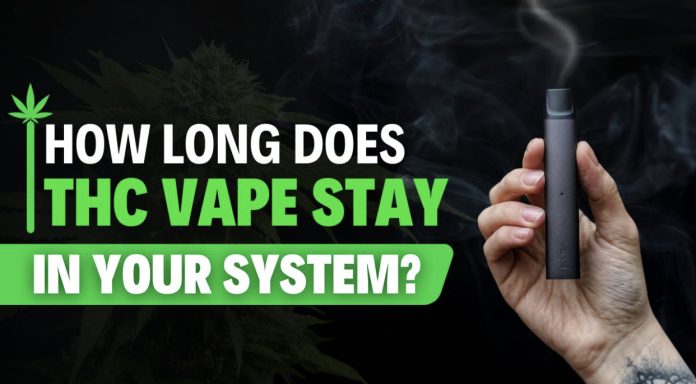
Are you a fan of the THC vape craze but worried about its lingering effects? Brace yourself for the ultimate guide on how long THC vape sticks around in your system.
From the moment you take that first puff to passing a surprise drug test, we’ve got all the juicy details you need to know!
What Is THC Vape?
THC vape refers to the consumption of tetrahydrocannabinol (THC), the psychoactive compound found in cannabis, through the use of vaporization devices such as vape pens or vaporizers. THC vape products typically contain concentrated THC oil or extracts derived from cannabis plants.
When heated, these products produce vapor that can be inhaled, allowing users to experience the euphoric and psychoactive effects of THC without the need for combustion or smoking traditional cannabis flower.
THC vape has become increasingly popular due to its convenience, discretion, and ability to deliver potent doses of THC with minimal odor and smoke.
How Is THC Vape Metabolized in the Body?
When THC vape is inhaled, the active compounds are rapidly absorbed through the lungs into the bloodstream.
From there, THC travels to the liver, where it undergoes metabolism. In the liver, THC is primarily metabolized into 11-hydroxy-THC, a more potent metabolite, and then further broken down into inactive compounds such as THC-COOH.
These metabolites are eventually excreted from the body through urine and feces. The process of metabolism and elimination varies from person to person and can be influenced by factors such as individual metabolism, dosage, frequency of use, and overall health.
Effects of THC Vape on the Body
THC vape affects the body primarily through its interaction with the endocannabinoid system, a network of receptors and neurotransmitters involved in regulating various physiological processes.
When THC vape is inhaled, the active compounds are rapidly absorbed into the bloodstream and distributed throughout the body.
THC binds to cannabinoid receptors in the brain, particularly the CB1 receptors, leading to a range of effects, including [1]:
- Euphoria and Relaxation
- Altered Perception
- Increased Appetite
- Cognitive Effects
- Motor Impairment
- Potential Anxiety and Paranoia
How Long Does THC Vape Take To Kick In?
The onset time for THC vape can vary depending on factors such as dosage, individual metabolism, and method of consumption. Generally, when vaping THC, users may start to feel the effects within a few minutes to around 15 minutes after inhalation.
This rapid onset is due to the direct absorption of THC into the bloodstream through the lungs.
Compared to other methods of consumption such as edibles, which can take up to an hour or more to take effect, vaping offers a quicker onset of effects, making it a popular choice for those seeking immediate relief or recreational enjoyment.
However, it’s essential to start with a low dose and wait for the effects to fully kick in before consuming more to avoid overconsumption and potential adverse reactions.
How Long Does THC Vape High Last?
The onset time for THC vape can vary depending on factors such as dosage, individual metabolism, and method of consumption.
Generally, when vaping THC, users may start to feel the effects within a few minutes to around 15 minutes after inhalation. This rapid onset is due to the direct absorption of THC into the bloodstream through the lungs.
Compared to other methods of consumption such as edibles, which can take up to an hour or more to take effect, vaping offers a quicker onset of effects, making it a popular choice for those seeking immediate relief or recreational enjoyment.
However, it’s essential to start with a low dose and wait for the effects to fully kick in before consuming more to avoid overconsumption and potential adverse reactions.
THC Vape Half Cycle
The THC vape half-cycle refers to the period of time during which the effects of vaping THC gradually diminish by half from their peak intensity. After reaching the peak of the high, users enter the half-cycle phase, where the euphoria and psychoactive effects begin to decline.
During this phase, individuals may experience a gradual return to baseline consciousness, with diminishing sensations of euphoria, relaxation, and altered perception.
While the duration of the half-cycle can vary depending on factors such as dosage, individual metabolism, and the specific strain of cannabis, it typically occurs within a few hours after the peak of the high.
As the effects of THC continue to subside, users may feel more grounded and mentally clear, eventually returning to their normal state of mind and function. Understanding the THC vape half-cycle can help users anticipate the duration of the high and make informed decisions about consumption.
Factors Affecting How Long THC Remains Detectable in Your System
Several factors can influence how long THC (the psychoactive compound in cannabis) remains detectable in your system:
- Frequency of Use: Regular or heavy cannabis use can lead to the accumulation of THC and its metabolites in the body, resulting in a longer detection window.
- Type of Cannabis Product Used: The potency of the cannabis product consumed, whether it’s delta 8 flower, concentrates, or edibles, can impact how much THC is ingested and subsequently metabolized by the body.
- Metabolism and Body Composition: Individual factors such as metabolism, body fat percentage, and overall health can affect how quickly THC is metabolized and eliminated from the body. Faster metabolisms and lower body fat percentages may result in quicker clearance of THC.
- Dosage: Higher doses of THC result in higher concentrations of THC and its metabolites in the body, extending the detection window compared to lower doses.
- Method of Consumption: The method by which cannabis is consumed can also affect the detection window. Inhalation methods such as smoking or vaping typically lead to more rapid onset of effects but shorter detection times compared to oral ingestion methods like edibles.
- Hydration Level: Hydration status can impact the concentration of THC metabolites in urine, with higher hydration levels potentially leading to more dilute urine and shorter detection windows.
- Exercise: Physical activity can increase metabolism and promote the elimination of THC from the body, potentially shortening the detection window.
Does Cannabis Vape Show up in Drug Tests?
Yes, THC vape can show up in drug tests, depending on the type of test being used and the timing of consumption. Most drug tests are designed to detect the presence of THC or its metabolites in biological samples such as urine, blood, saliva, or hair.
Since THC vape delivers THC directly into the bloodstream, it can be detected by drug tests in a manner similar to other forms of cannabis consumption.
How to Clear THC From the Body
Clearing THC from the body can take time, as the compound and its metabolites can linger in various tissues and fluids. While there’s no foolproof way to rapidly eliminate THC from the body, several strategies may help speed up the process:
- Hydration: Drinking plenty of water can help flush THC metabolites out of the body through urine. However, excessive water consumption can lead to water intoxication, so it’s essential to stay hydrated without overdoing it.
- Exercise: Regular physical activity can boost metabolism and promote the elimination of THC through sweat and urine. However, it’s essential to avoid exercising excessively close to a drug test, as this may temporarily increase THC levels in urine due to the release of stored THC from fat cells.
- Detox Products: Some individuals may opt to use over-the-counter detox products or supplements marketed as “detox kits” or “cleanses” to help eliminate THC from the body. However, the effectiveness of these products is debated, and some may have adverse effects or interfere with drug test results.
- Time: Ultimately, the most reliable way to clear THC from the body is to allow it to metabolize and be eliminated naturally over time. THC and its metabolites typically clear from the body within a few days to several weeks, depending on factors such as frequency of use, dosage, metabolism, and individual physiology.
Types of Marijuana Drug Tests and THC Detection
There are several types of drug tests used to detect the presence of THC (the psychoactive compound in marijuana) and its metabolites in the body:
- Urine Drug Test: Urine tests are the most common type of drug test used to detect THC. These tests are non-invasive, easy to administer, and can detect THC metabolites in urine samples. Urine tests can typically detect THC metabolites for several days to weeks after cannabis use, depending on factors such as frequency of use and individual metabolism.
- Blood Test: Blood tests can also detect THC and its metabolites in the bloodstream. These tests are more invasive than urine tests and are often used in situations where recent cannabis use is suspected, such as in traffic accidents or DUI investigations. Blood tests can typically detect THC for a few hours to several days after use.
- Saliva Test: Saliva tests are becoming increasingly popular for detecting recent cannabis use. These tests are non-invasive and can detect THC and its metabolites in saliva samples. Saliva tests are often used in roadside drug testing or workplace screening. They can typically detect THC for a few hours to one or two days after use.
- Hair Test: Hair tests are less common but can provide a longer detection window for cannabis use. THC and its metabolites can be incorporated into hair follicles over time, allowing hair tests to detect cannabis use for several months to years after use. Hair tests are often used in forensic and legal settings.
Final Word: How Long Does Cannabis Vape Stay in Your Body?
As you embark on your THC vape journey, remember that everyone’s body is unique, and factors like metabolism and usage habits can influence how long THC lingers in your system.
Armed with knowledge and a dash of caution, you can navigate the world of THC vape with confidence and enjoy the highs without the lows. So puff away, my friends, and may your THC adventures be long and euphoric!
References
- Zou S, Kumar U. Cannabinoid Receptors and the Endocannabinoid System: Signaling and Function in the Central Nervous System. Int J Mol Sci. 2018 Mar 13;19(3):833. doi: 10.3390/ijms19030833. PMID: 29533978; PMCID: PMC5877694.
Disclaimer: This article contains sponsored marketing content. It is intended for promotional purposes and should not be considered as an endorsement or recommendation by our website. Readers are encouraged to conduct their own research and exercise their own judgment before making any decisions based on the information provided in this article.

































